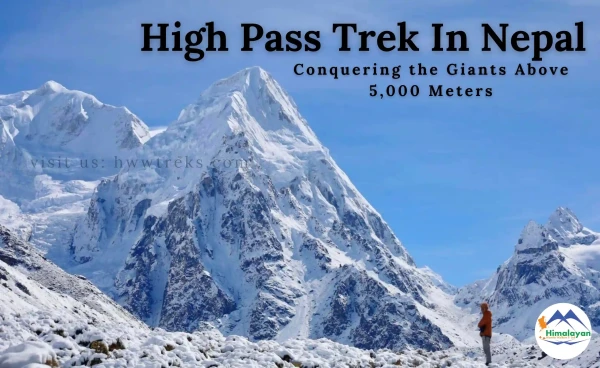- 10/24/2025
- Tags: places to see in Mustang
- Himalayan Wander Walkers
Places To Visit During Upper Mustang Trek
Mustang, despite being a small region of Nepal, is well-known to both domestic and foreign travelers. What makes it most famous is that it is the Hidden Kingdom of Nepal, where a royal dynasty led by "Jigmey Dorje Palbar Bista" reigned until 2009. Every place in Mustang has a different story to tell. Mustang provides a wide range of geographical and religious creations that have attracted people's interest across the globe. There are several fascinating monasteries and caves, each with unique histories and specializations.
Mustang's appeal is further influenced by its unique customs, ancient festivals, and combination of Tibetan Buddhist culture. For example, the yearly Tiji Festival is a lively event that draws lots of tourists. Mustang is one of Nepal's most distinctive travel destinations because it offers a captivating fusion of history, culture, and adventure, whether visitors are there to explore its royal palaces, meditate in its sacred places, or simply take in the breathtaking scenery. There are a lot of sights and things to do while traveling to Mustang; some of them are included here.
Contents [hide]
- 1. Mustang Gate
- 2. Kali Gandaki
- 3. Lo-Manthang
- 4. Lo Gekar Gompa(Ghar Gompa)
- 5. Shija Dzong Cave
- 6. Teri Khechoe Ri
- 7. Mardzong
- 8. Chungsi Rangchung Cave Monastry
- 9. Konchhokling or Kunchokling
- 10. Rinchenling
- 11. Luri Gompa
- 12. Summer Palace, Lo Thinkar
- 13. Tange Village
- 14. Tashi kabung
- 15. Choedzong Gompa
- 16. Namgyal Gompa
- 17. Dhakmar
- 18. Nomadic Yak Herders of Lo-Manthang
- Conclusion
1. Mustang Gate

This place is not exactly a gate where we can see a wooden or metallic door which opens or closes. This is a sandy-stoned hill with many small holes which from a far distance will look like a window but in actuality is a cave. These holes are thought to have historical and religious significance and to mimic the text of the sixteen buddhas, which is thought to have been kept there during the period of Guru Padmasambhava. These holes are in a horizontal direction which makes them look like someone has intentionally carved them there. This cave is located in Chelle village of mustang. Below that cave (hill), Kali Gandaki river flows and while travelling to the upper mustang one can see the caves on the way. In olden times there used to be a single bridge for people to cross by foot, but now near that old bridge is a new bridge for vehicles to cross.
2. Kali Gandaki
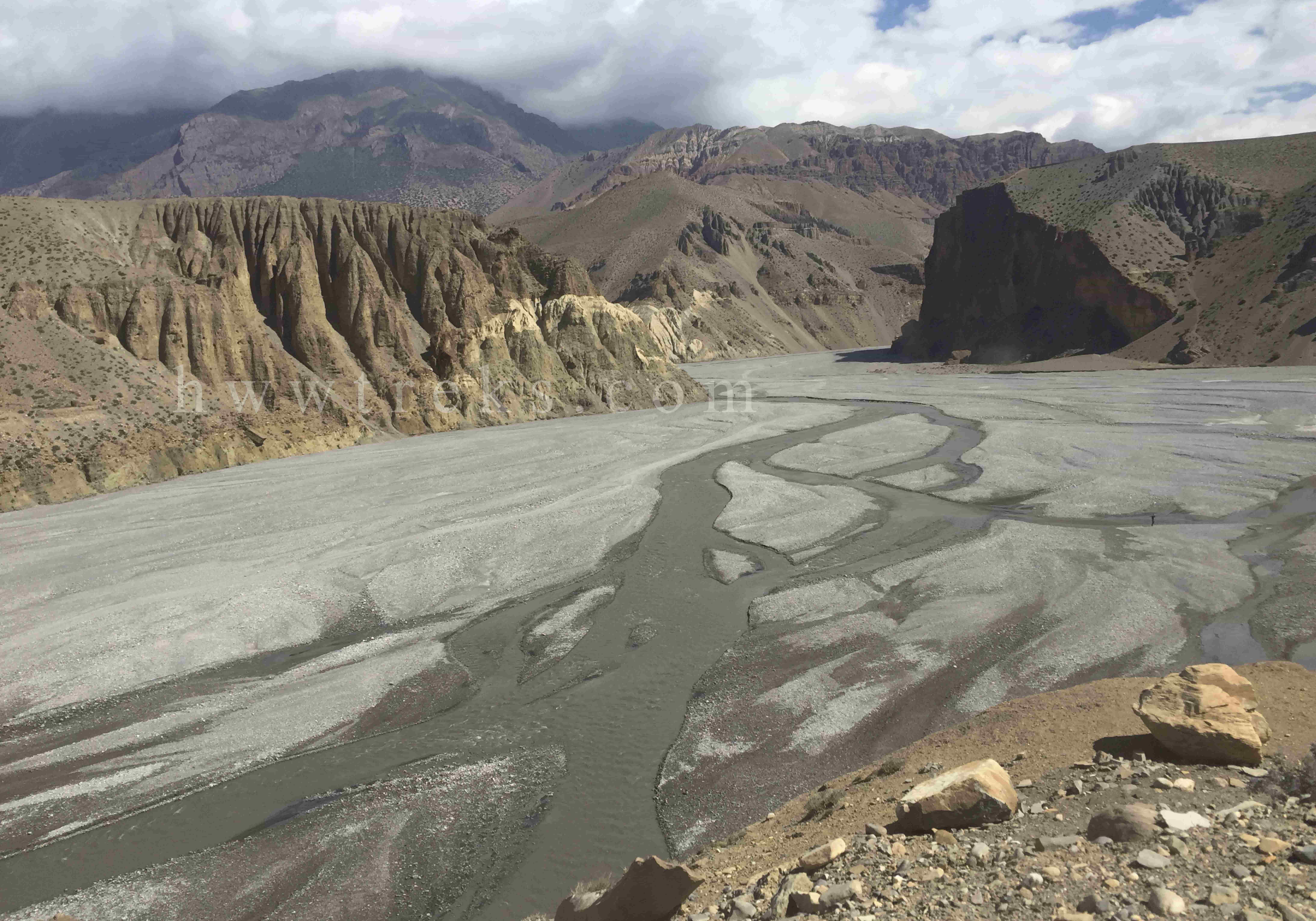
The Kali Gandaki, also known as "The Holy River" and named after the goddess Kali, rises in Mustang, a Nepalese refuge on the northern slope of the Himalayas. It forms one of the deepest river canyons in the world as it descends between the Annapurna and Dhaulagiri hills. On the bank of Kali Gandaki river, one can find a special fossil rock known as “Shaligram” which is worshiped by many Hindu and Buddhist people and also kept in temples, monasteries for religious purposes.
Kali Gandaki was formerly a well-traveled trekking path and an important commerce route to Tibet. It is an amazing mid-length river trip that offers fantastic whitewater combined with some of Nepal's most beautiful scenery, rarely seen villages, and genuinely peaceful and contemplative evenings. Rafters of all skill levels will enjoy it. In really high water, the Kali Gandaki rapids are not a place to be unless you are an experienced rafter with a good sense of avoiding major holes. Every river crossing on the Kali Gandaki, one of the holiest rivers in Nepal, is lined with above-ground burial mounds and cremation sites. One can even do trekking in Kali Gandaki region, if they wish to where they will be trekking through the local village near the river. Gurung, Thakali, and Manangba ethnic groups are the most well-known in this area. One gets to explore the breathtaking countryside, caves, and historic monasteries. Pika, blue sheep, and Himalayan thar are among the wildlife. The great diversity of vegetation on the Kali Gandaki Trek is matched by an amazing variance of elevation and large number of tea houses.
3. Lo-Manthang
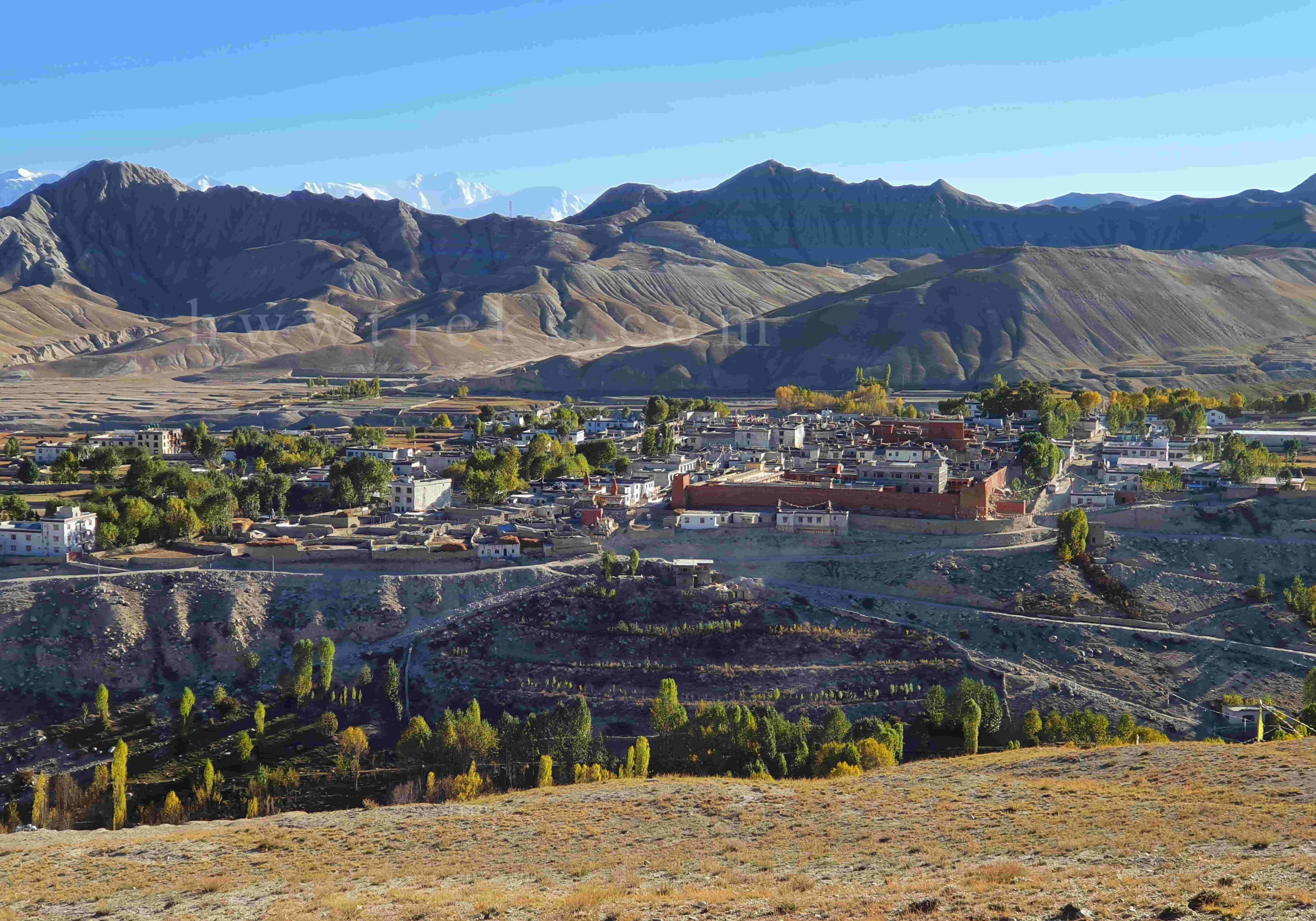
The word lo-manthang has many meanings. Some called it a medicine place (herbs growing land) for lowa (people living in lo), some called it a wish-fulfilling place, and to the world, it is known asthe “Ancient Wall City” of Mustang. Nowadays, Lo-Manthang, serves as a main attraction for tourists, as it is well known for its tall, white-painted mud-brick walls, Gompa, and royal palace. Here one can find modernization by being in contact with traditional lifestyle and culture. For accommodation in Lo Manthang, there are several hotels, homestays, and guest houses for tourists that offer both on-demand Western cuisine and real, traditional meals. People in Lo Manthang are very friendly, and welcoming and always have a smile to offer on their faces. The city “Lo-Manthang” is home to three main sacred monasteries: Jampa, Thupchen, and Chode, all belonging to the Sakyapa sect of Tibetan Buddhism. Jampa Monastery, built in the 14th century, houses a massive Maitreya Buddha statue and 108 ancient mandalas. Thupchen Monastery, from the 15th century, features intricate murals and hosts the annual Tiji Festival. Chode Monastery, founded in the 13th century, is a key center for Buddhist studies and also participates in the Tiji Festival. These monasteries are culturally significant and reflect the region's deep spiritual heritage.
4. Lo Gekar Gompa(Ghar Gompa)
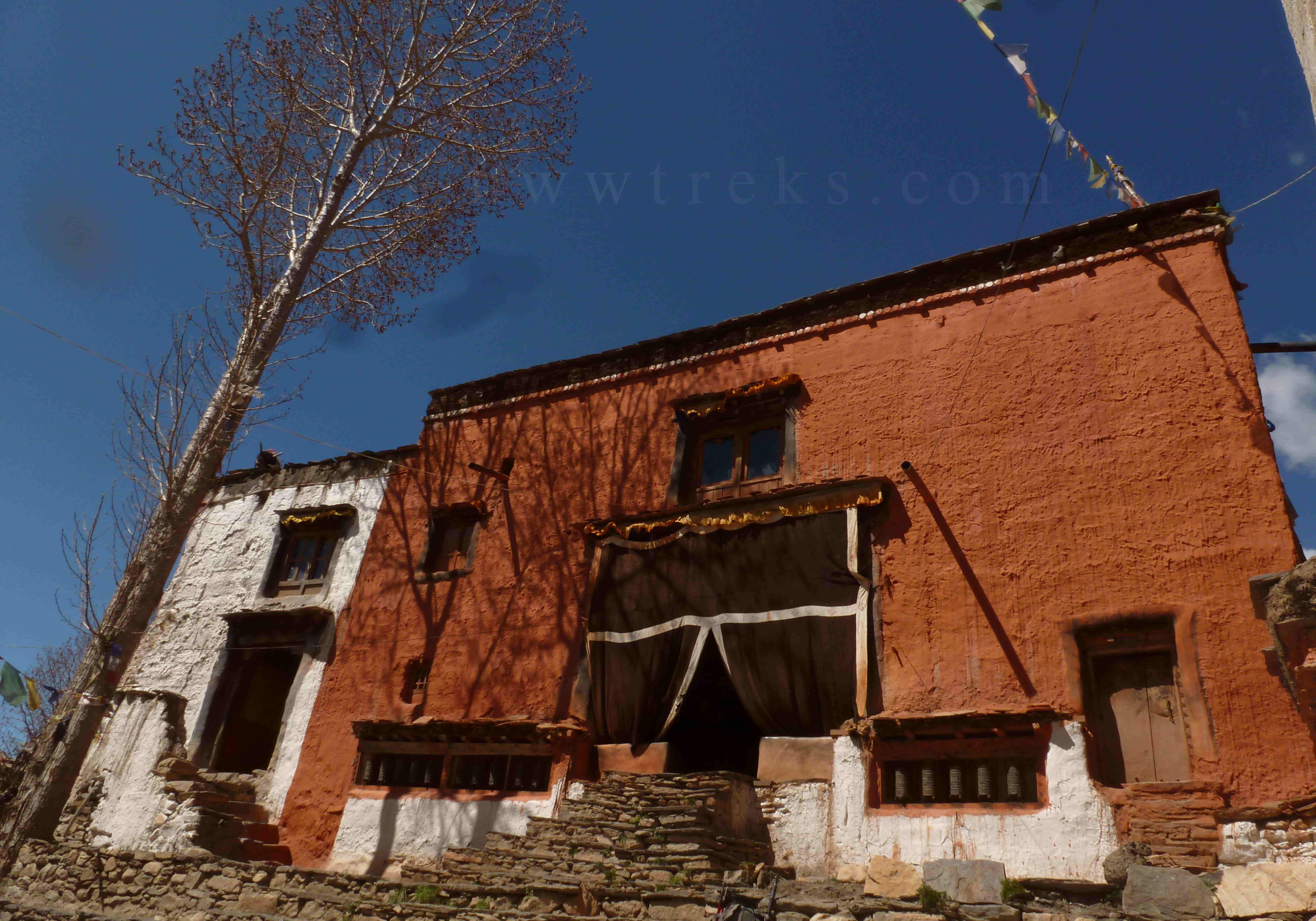
Ghar Gompa, also known as "Lo Gekar Gompa," is the oldest monastery of Mustang, constructed in the 8th century by the legendary Tibetan guru Padmasambhava, also known as Guru Rinpoche, who is believed to have introduced Buddhism to Tibet and Nepal. Ghar Gompa has many murals, paintings, and old texts that portray the lives of Guru Rinpoche and the Buddha. As a sacred site linked to the Nyingma sect of Buddhism, Ghar Gompa is considered a place of great spiritual power and historical relevance for Buddhists worldwide.
The monastery is located at an elevation of 3,931 meters above sea level and offers breathtaking views of the Kali Gandaki River and the surrounding Himalayan landscape. It lies in the heart of the ancient Lo Kingdom, near the village of Marang in Mustang, and is encircled by prayer flags, chortens, red plants, and yellow trees. The architecture of the gompa is distinctive, with intricate murals, ancient paintings, and sacred texts that depict the lives of Guru Rinpoche and the Buddha. For Buddhists, Ghar Gompa possesses enormous spiritual value as it is not only a place of prayer but also a pilgrimage location where devotees seek blessings and enlightenment. It's an accumulation of Buddhist history, art, and knowledge because it has centuries-old murals and sacred texts. The monastery’s location and the legends associated with it enhance its importance as a center for meditation and reflection, especially for those following the teachings of Guru Rinpoche. Sacred Ghar Gompa is a must-visit place for everyone interested in learning more about the historical Buddhist culture, rare artwork, gorgeous architecture, and breathtaking Himalayan scenery. It is a well-known pilgrimage site that draws tourists from all over the world because of its unique architecture, beautiful murals, and spectacular natural beauty.
Legend of Ghar Gompa
When Samye, the first Buddhist monastery in Tibet, was being built near what is now Lhasa, its construction was mysteriously sabotaged over and over. As the story goes, demons were destroying it each time the walls began to rise. The builders and spiritual leaders were left confused and helpless.
It was then that Ghar Gompa came into the picture. To calm the dark forces and remove obstacles, a new monastery was built in Mustang, Ghar Gompa. Once this sacred site was completed and blessed, the trouble at Samye stopped, and its construction continued without further disturbance.
This legend is closely tied to Guru Rinpoche (Padmasambhava), the great master of Vajrayana Buddhism, who is believed to have visited Ghar Gompa himself. It is said that during his visit, he hid sacred texts, known as “terma,” within the monastery, later to be discovered in the future by destined spiritual teachers. Since Guru Rinpoche also founded Samye Monastery between 775 and 787 AD, this connection suggests that Ghar Gompa is not only spiritually powerful but also one of the oldest continuously active monasteries in Nepal.
5. Shija Dzong Cave
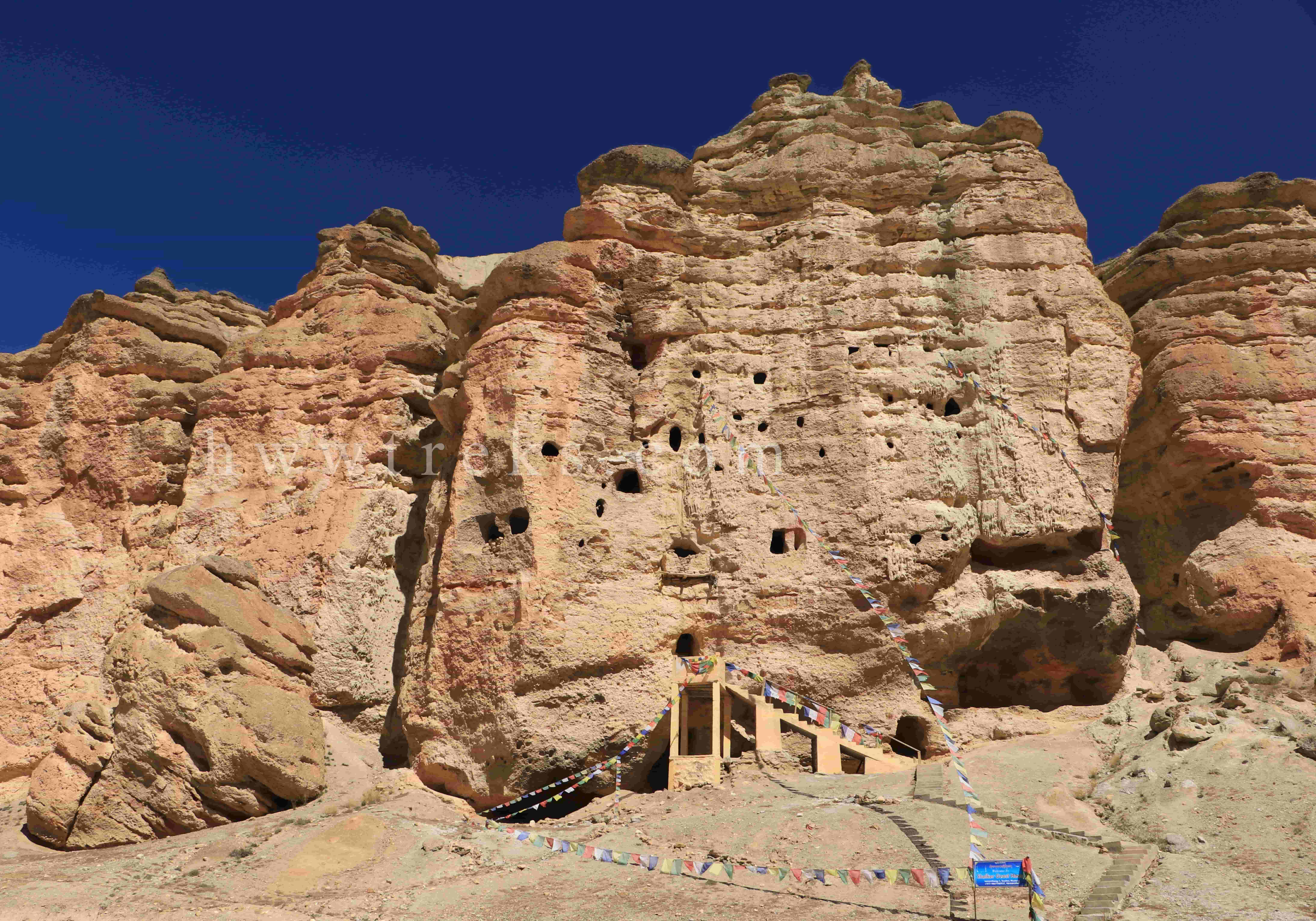
Chhoser village of mustang is well known for natural caves. The Chhoser Caves are worth seeing as they are carved out of the rock face and were formerly inhabited by the area's ancient residents. It is believed that families have been residing in several of these caves for many generations. Among them the most famous cave is the Dzong cave which is also known as “Shija Dzong Cave”. This cave attracts more than thousands of tourists annually from all over the world along with many researchers and archeologists.
Shija Dzong Cave, situated within a cliff face, is a remarkable five-story cave located in Upper Mustang. Despite having a tiny and narrow entrance, the cave contains more than 40 different rooms and the space inside the cave is like a tunnel with some kind of black paint on the wall. A normal adult cannot fully stand straight in those rooms and needs to bend their head while moving forward. There is a natural skylight inside the cave that lets in natural light and air. Visitors have to climb steep stairs in order to enter this cave. There are numerous ladders inside the cave that lead from one floor to another. From the window-like hole of the 5th floor of the cave, one can have a breathtaking view of the Chhoser Valley and the surrounding mountains. There are many unanswered questions and mysteries surrounding the creation of Dzong Cave. It is presumed that during the old Tibetan War, the people of Mustang carved Dzong Cave and other higher Mustang caves to guard against enemy threats and issues. They also used this cave as a means of keeping off the cold and snow.
6. Teri Khechoe Ri
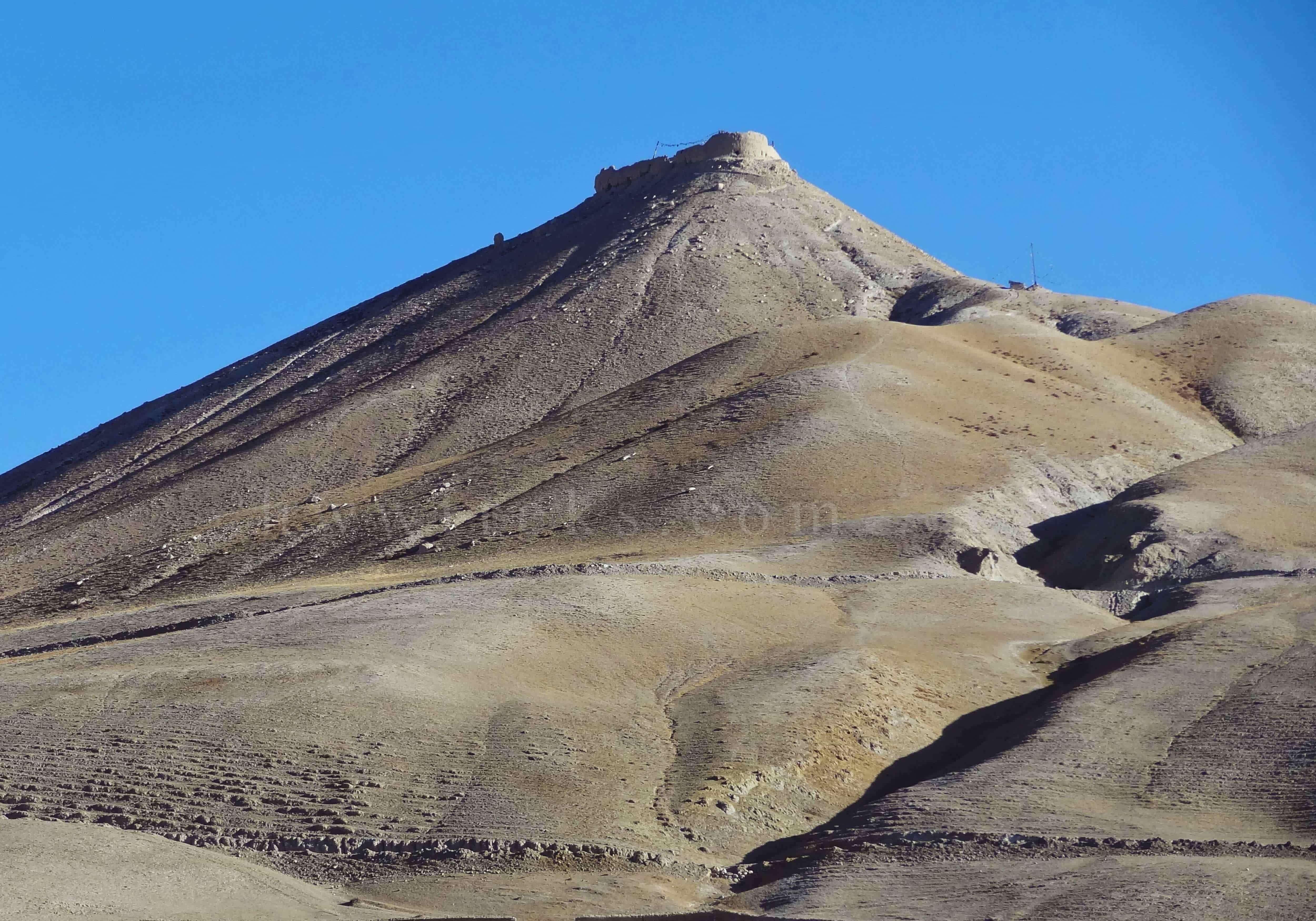
Teri Khechoe Ri is a prominent hill in the Mustang region of Nepal, best known for being the home of the palace of Ame Pal, the first monarch of Mustang. It was the king Ame Pal who founded the “Ancient Wall City” Lo-Manthang in 1380. The term "Ri" means hill in the local language, and on that hill there are two palaces. The palace at the summit was reserved for the king, while a second, lower palace was constructed for the queen.
Today, these historical structures serve as view towers, offering panoramic vistas of the surrounding Mustang landscape and preserving the legacy of the region's royal past.
7. Mardzong
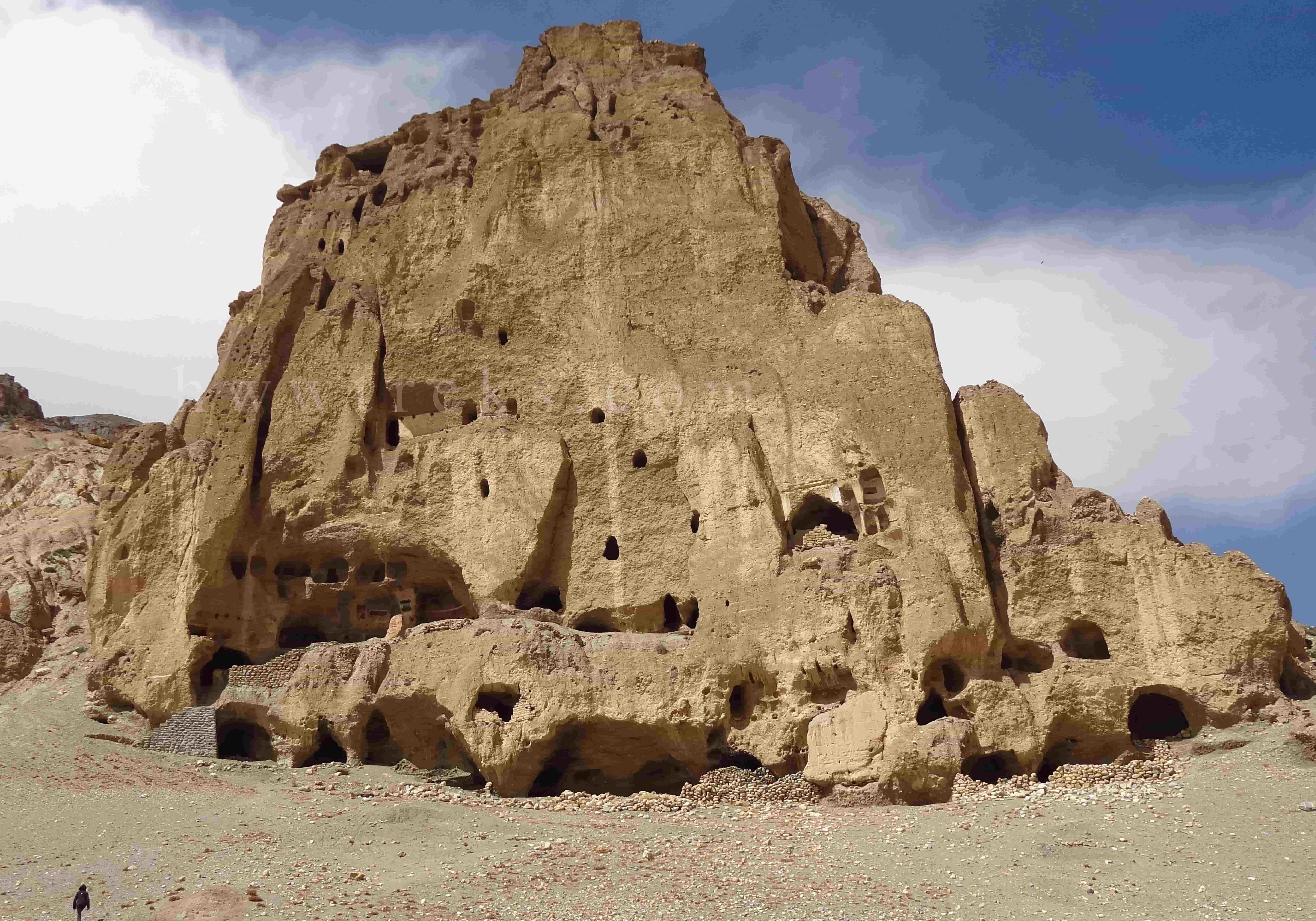
Mardzong, a cave in Mustang, is well-known for its fascinating hundreds of old artificial caves all in a single rock-like hill. These caves, which date back more than 3,000 years, were utilized for meditation, sleeping, and the burial of ancient lamas, and for this reason, they hold many religious beliefs. Even the locals visit this place often and do their prayers and rituals. This cave has been a major attraction for a lot of tourists and researchers all over the world. The natural hot spring of Mustang is also situated near Mardzong.
8. Chungsi Rangchung Cave Monastry

Between Sammar and Syangboche village, on the route to Upper Mustang, is Rangchung Cave. Here the word "Rangchung" means "self-arisen and not man-made." It's typically referred to as a Chungsi cave or Chungsi Gompa, a well-known pilgrimage site in Mustang for both Buddhists and Hindus. It is thought that around the eighth century or so, Guru Rinpoche meditated in this cave, which makes it similar to the Maratika Cave of Halesi, Khotang. Situated above the cave is the monastery where Padmasambhava practiced meditation. The Hindu god Shiva is also connected to the cave, as it is thought to be the location of his meditation stop on the way to Kailash.
Chungsi Cave is a naturally occurring cave situated amidst thousands of man-made sky caves in Mustang. Numerous deities that resemble the self-arisen can be found on the walls of the Chungsi cave. For ages, the locals have used these caverns as a place of prayer, meditation, and solitude by offering lighting incense, prayer flags, and oil lamps. Natural light enters the cave through tiny holes, creating a mysterious environment. The cave's lama said that the stone was used to construct a back pain remedy. There is a particular method for producing medicine from this stone that the locals still employ, according to ancient Tibetan medicine. From the Chungsi Cave, views of the canyon in upper Mustang appear to be breathtaking. It is one of the Upper Mustang Trek's attractions, so if you visit Mustang, do not miss it.
9. Konchhokling or Kunchokling

Konchhokling, located in Nepal's Mustang region, is best known for its breathtaking landscape and panoramic views that captivate visitors. Nestled amidst Mustang’s rugged terrain, the cave offers a sense of serenity and awe, making it a haven for those seeking both natural beauty and spiritual reflection. From the cave, one can take in stunning vistas of towering red rock cliffs and the majestic Himalayan mountains, which stretch across the horizon. The journey to Konchok Ling itself is a rewarding experience, as visitors must hike through the region’s rugged terrain, with the trail offering even more striking views of Mustang’s dramatic landscape. The surrounding mountains, expansive skies, and tranquil environment are the primary draws for tourists and pilgrims alike, providing a peaceful escape from the outside world.
In addition to its stunning surroundings, Konchhokling is also home to remarkable cultural and spiritual treasures. The cave's walls feature large, detailed paintings of revered deities like Tara, Avalokiteshvara, Chaturbhuja, and Vajradhara, embodying Buddhist symbolism and devotion. One of the cave's most remarkable aspects is its depiction of the Vajrasana System's Eighty-Four Mahasiddhas, spiritual masters who achieved enlightenment. Additionally, it houses a four-line poem from the 11th century, written by Vairasana, an abbot of Bodhgaya, further enhancing its religious significance. For locals, Konchok Ling is a site of pilgrimage, deeply revered for its spiritual significance. For visitors, it offers a holistic experience, where Mustang’s natural beauty and profound religious history come together to create a truly unique destination.
10. Rinchenling
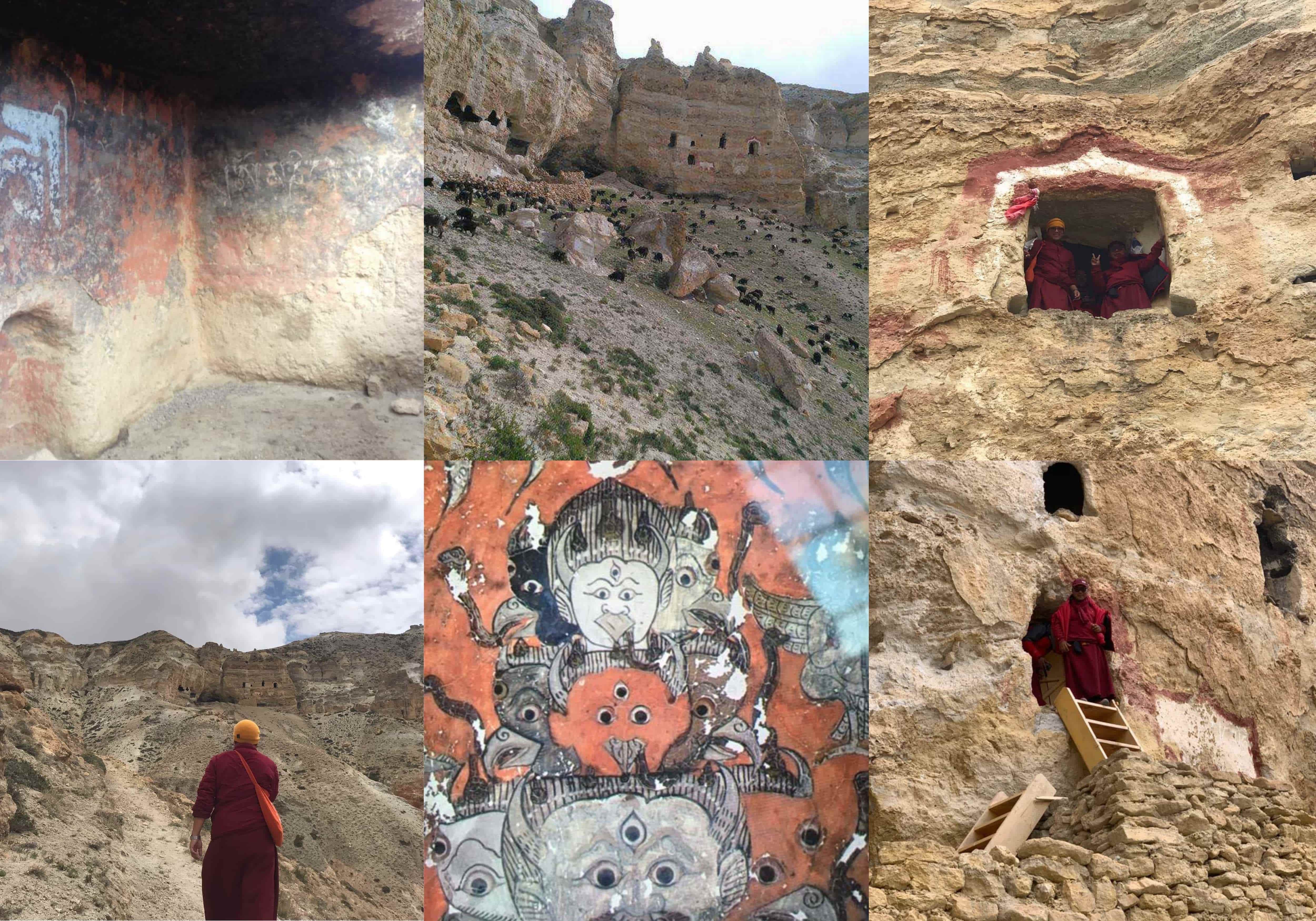
Rinchenling, located near Kunchokling in Nepal's Mustang region, is another site of deep spiritual and cultural significance, renowned for its remarkable caves and intricate murals. Unlike Konchok Ling, which is celebrated for its landscape and the Vajrasana System's depictions, Rinchen Ling stands out for its unique portrayal of various tantric deities and mandalas, central to the Vajrayana Buddhist tradition. The cave walls are adorned with vibrant murals that illustrate sacred Buddhist teachings, offering visitors a profound insight into ancient religious practices and beliefs.
One of Rinchen Ling’s religious highlights is its depiction of Padmasambhava, the revered Guru Rinpoche who is believed to have introduced Buddhism to Tibet and the Himalayan regions. The cave also features depictions of protector deities and elaborate mandalas, which symbolize the universe in Buddhist cosmology and serve as meditation tools for those seeking spiritual enlightenment. Rinchen Ling offers an equally enriching experience for those interested in Mustang's artistic and religious heritage. Together, these two sacred sites form a vital part of the region’s spiritual landscape, attracting pilgrims and visitors eager to explore the profound depths of Mustang's Buddhist traditions. With its rich iconography and religious significance, Rinchen Ling is a must-visit destination for those on a spiritual journey through Mustang.
11. Luri Gompa

Luri Gumba is a historic Buddhist monastery and cave complex in the Upper Mustang region. Located on a cliff face, the monastery is made up of interconnected caves, chortens, and prayer flags, offering a striking view of the surrounding rugged landscape. Inside the caves, the walls are decorated with intricate murals depicting the life of Buddha and his teachings, making it a significant spiritual site. One of the key features of the monastery is a chorten, which is decorated with the eight auspicious symbols of Buddhism and protected by four guardian deities. Numerous paintings depict the lama and mandalas.
As a sacred pilgrimage site, Luri Gumba holds immense cultural and religious importance for both spiritual seekers and adventurers. The monastery is a testament to the rich Buddhist heritage of Mustang, offering a rare glimpse into centuries-old religious art and traditions. It is not only a spiritual center but also a historical landmark that showcases the region’s connection to Tibetan Buddhism. Trekking to Luri Gumba is a popular yet challenging activity, requiring good physical fitness due to the high altitude and rugged terrain. The trek allows travelers to experience Nepal’s natural beauty while immersing themselves in the cultural and spiritual history of Mustang. For those seeking adventure and enlightenment, Luri Gumba offers an unforgettable experience that combines breathtaking scenery with profound spiritual significance.
12. Summer Palace, Lo Thinkar
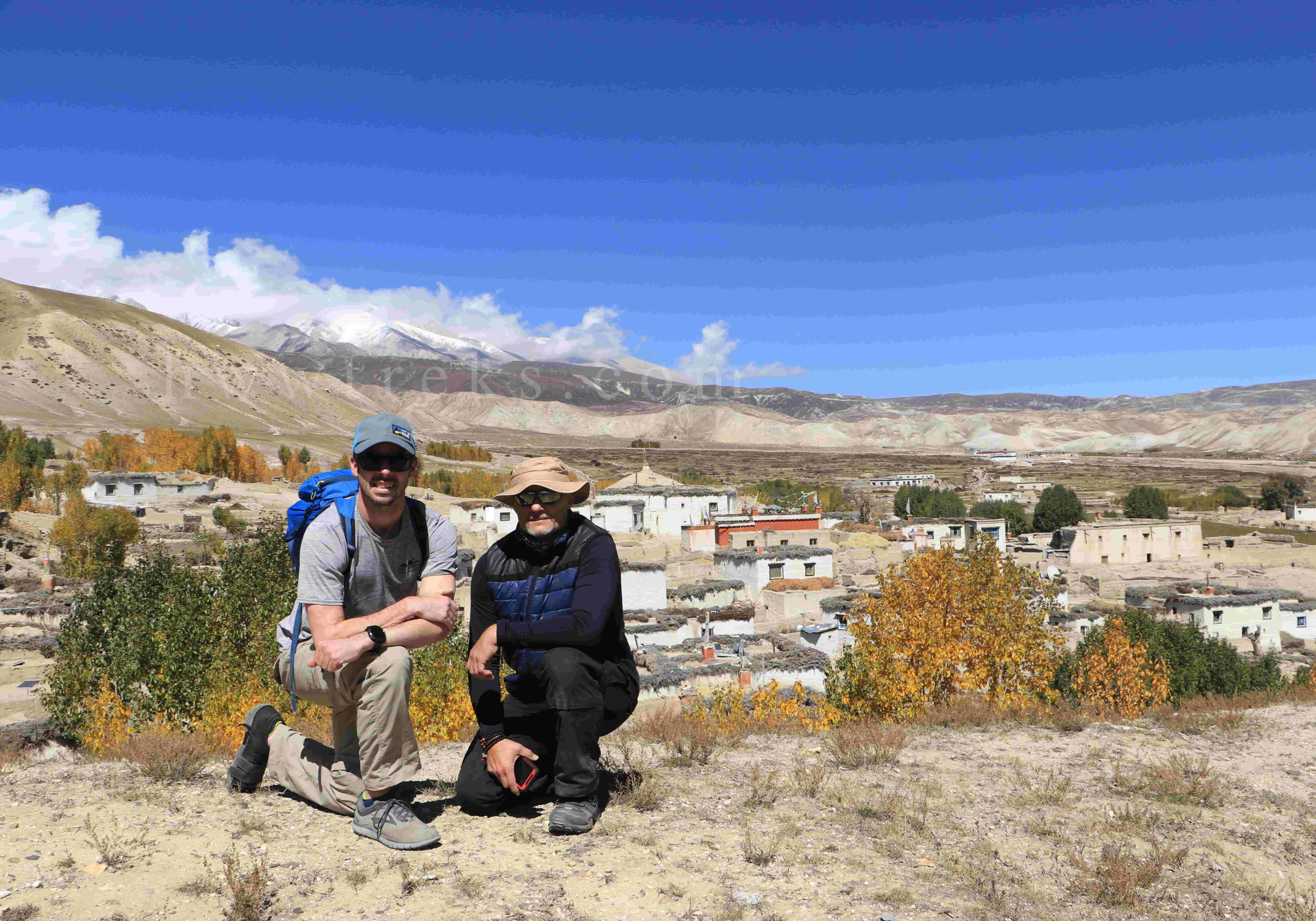
The Summer Palace, located in the beautiful village of Mustang region, Thinkar, is a serene retreat that once served as the royal summer residence for the King of Mustang. Located atop a hill, the palace offers commanding views of the surrounding landscape, including other villages, ranges of hills, and the majestic Himalayan mountains. Its elevated location not only provided the royal family with a cool and pleasant refuge during the warmer months but also offers visitors today an extraordinary vantage point to take in Mustang's breathtaking scenery. Lo Thinkar village itself is a vibrant, green oasis, especially during the summer and spring seasons. The village comes alive with lush greenery, wide-open meadows, and large expanses of grass-covered land, creating an atmosphere of tranquility and beauty. The fertile grounds make it an ideal spot for relaxation, as visitors can enjoy the village’s peaceful charm and the refreshing contrast it offers against Mustang’s often rugged and arid landscapes.
The Summer Palace is a blend of history and natural beauty, offering not only a glimpse into the life of Mustang’s royal family but also an experience immersed in the splendor of the surrounding environment. From the palace, one can gaze out over the verdant village below, admire the snow-capped mountains in the distance, and feel the gentle breeze from the expansive open grounds. The setting of Lo Thinkar, with its lush greenery and sweeping vistas, makes it a perfect destination for those seeking both cultural richness and the serene beauty of nature.
13. Tange Village
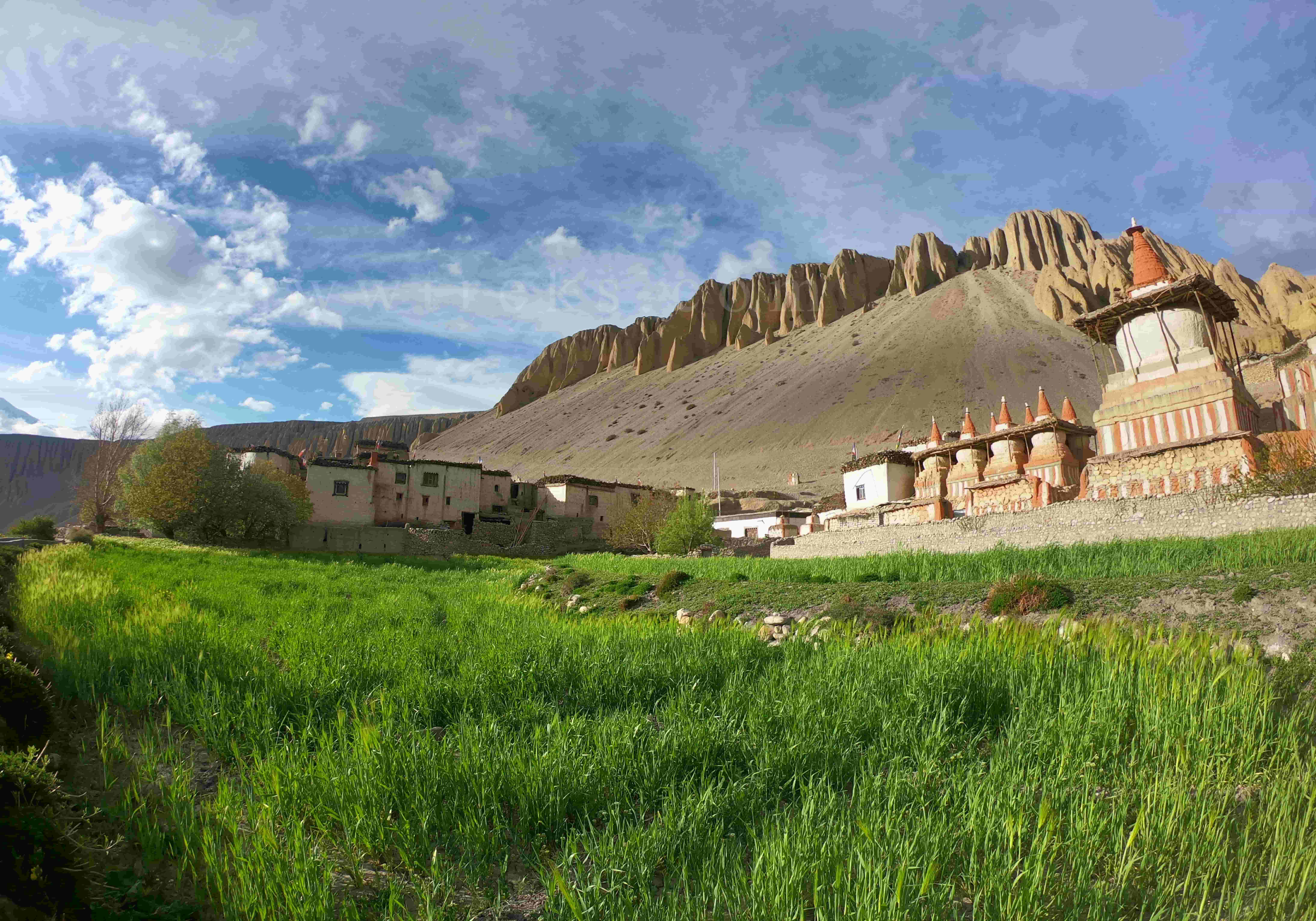
Tange Village, located in the remote eastern Upper Mustang region, is a hidden gem filled with cultural and historical treasures. With a population fluctuating between 150 and 200, Tange’s residents primarily raise sheep, yaks, and cows while also engaging in apple farming. A central highlight of Tange is its impressive mani wall, a long stone structure engraved with complex yet beautiful mandalas, Buddha images, and sacred scriptures. Unlike typical mani walls, the stones here are exceptionally detailed, making it one of the most remarkable in Nepal. Lining the wall are unique prayer wheels made from yak hide, adding to the village’s distinct spiritual atmosphere.
Tange is also known for its iconic chortens, which dominate the village landscape. There are five main chortens to the south, along with a cluster of eight conical-shaped chortens in the center, creating a fairytale-like scene. These structures are intricately designed, with faded paintings of Buddha inside some of them, although time and nature are slowly erasing their beauty. Surrounding the village, high cliffs are dotted with ancient caves, believed to be protected by the gods. Some caves are marked by small chortens or whitewashed walls, and though difficult to access, they remain an intriguing part of Tange’s mystical allure. Tange Village is a rare destination offering a glimpse into the preserved culture, spirituality, and history of Upper Mustang.
14. Tashi kabung
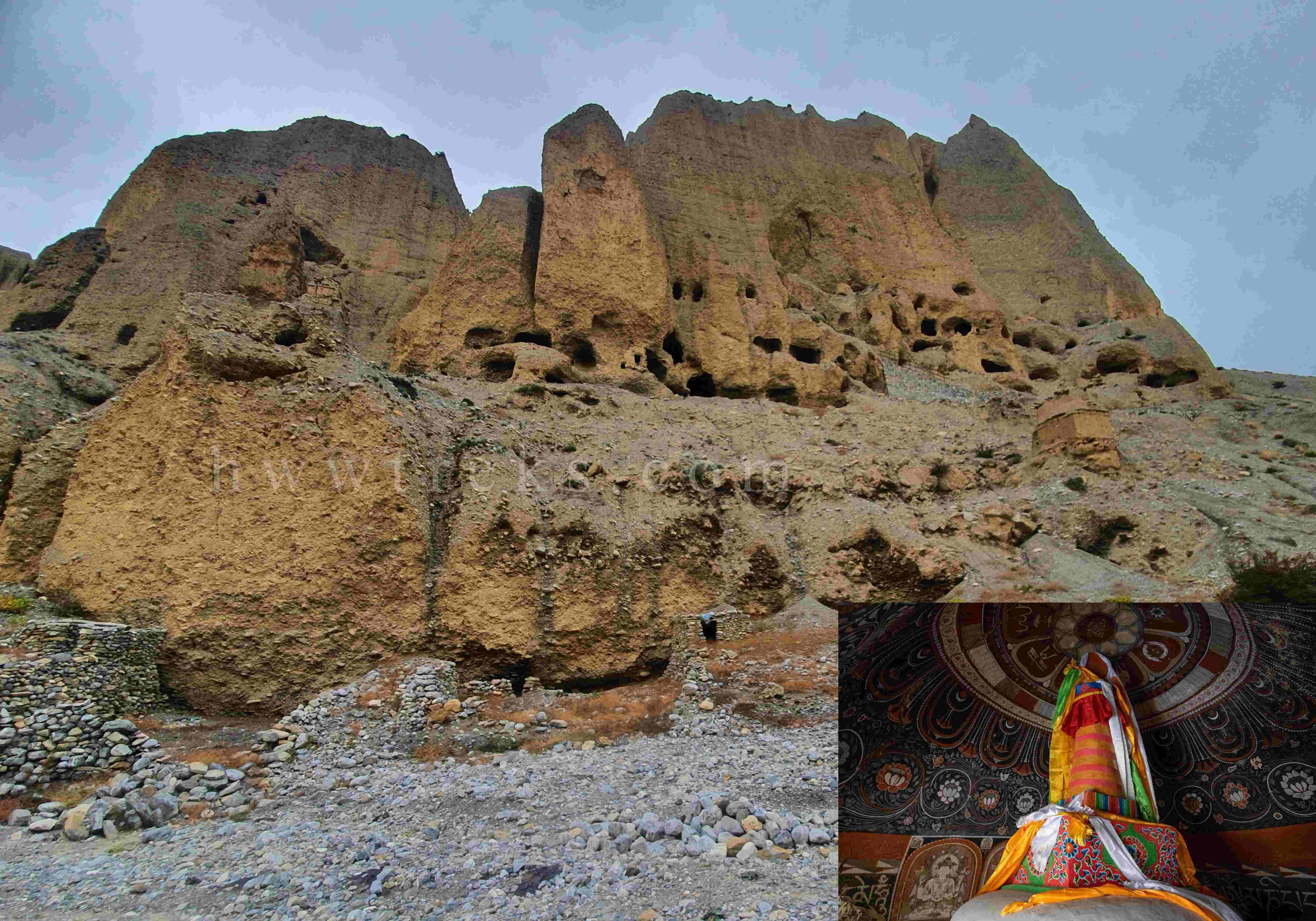
Tashi Kabum is a sacred cave monastery in Upper Mustang, located at an altitude of 3,650 meters. This ancient site, believed to have been built in the 14th century, is renowned for its religious significance and stunning murals. It features two hand-carved caves with intricately crafted chortens at their center, surrounded by beautiful murals of Buddhist deities and symbols, including the holy mantra "Om Mani Padme Hum."
The cave's dome-shaped ceilings are adorned with mandalas, enclosed by lotus petals and vajras, though some parts have been damaged over time. Despite this, the vibrant murals are well-preserved. Tashi Kabum is closely linked to Luri Gompa and is an important pilgrimage site for devotees seeking spiritual power and meditation. The trek to this cave from Yara village involves crossing the Puyon Khola and hiking narrow, rugged trails, offering breathtaking views of the valley. A visit to Tashi Kabum provides a deep connection to Mustang’s rich spiritual heritage and is a must for those looking to explore its religious history.
15. Choedzong Gompa

Choedzong Gompa (also known as Chhuzong Gompa) is a 13th-14th century Tibetan Buddhist monastery located at a high altitude of 3,900 meters in the remote Upper Mustang region. Set in a hidden valley surrounded by multi-colored gorges, the gompa is rarely visited and remains locked most of the time, protecting its ancient mysteries and cultural treasures.
Historically, the gompa is linked to the “Chod practice”, a spiritual tradition founded by the Tibetan yogini Machig Labdron. "Chod" means "to cut off" or "to slay" and refers to a profound tantric practice aimed at cutting through the ego and reaching enlightenment. Chod is found primarily in the “Yungdrung Bon” tradition as well as in the “Nyingma” and “Kagyu” schools of Tibetan Buddhism. Inside the cave like a Gompa, visitors can find ancient wall paintings and intricately carved wooden statues, reflecting its deep spiritual heritage. To access the gompa’s interior, travelers need to be accompanied by a Lama from Lo Manthang, which requires a full-day horse journey across streams and gorges, offering stunning views of the landscape along the way. The gompa represents both a physical and spiritual retreat, embodying the rich history, religious, and spiritual practices of Tibetan Buddhism, specifically emphasizing the transformative Chöd practice.
16. Namgyal Gompa

Namgyal Monastery, perched at 3,850 meters in Namgyal Village near Lo Monthang, is a significant religious center in the remote Mustang region of Nepal. Established in earlier times and expanded in the 15th century, it became a vital institution for Tibetan Buddhism, housing a large community of monks. Its remote location on a cliff enhances its spiritual aura, making it a peaceful sanctuary for meditation and religious practices.
The monastery holds immense religious importance due to its rich collection of Buddhist cultural treasures, including ancient statues, sacred thangkas, and valuable manuscripts. As a symbol of Tibetan Buddhist heritage, it serves not only as a spiritual hub but also as a guardian of traditions and teachings, maintaining deep religious and cultural connections with both the Mustang region and Tibet. The Bagcham, a traditional mask dance, is one of the main annual events at Namgyal Monastery. It is performed to protect harmony and prosperity in the valley. Namgyal Monastery remains a beacon of faith, drawing devotees and scholars alike.
17. Dhakmar
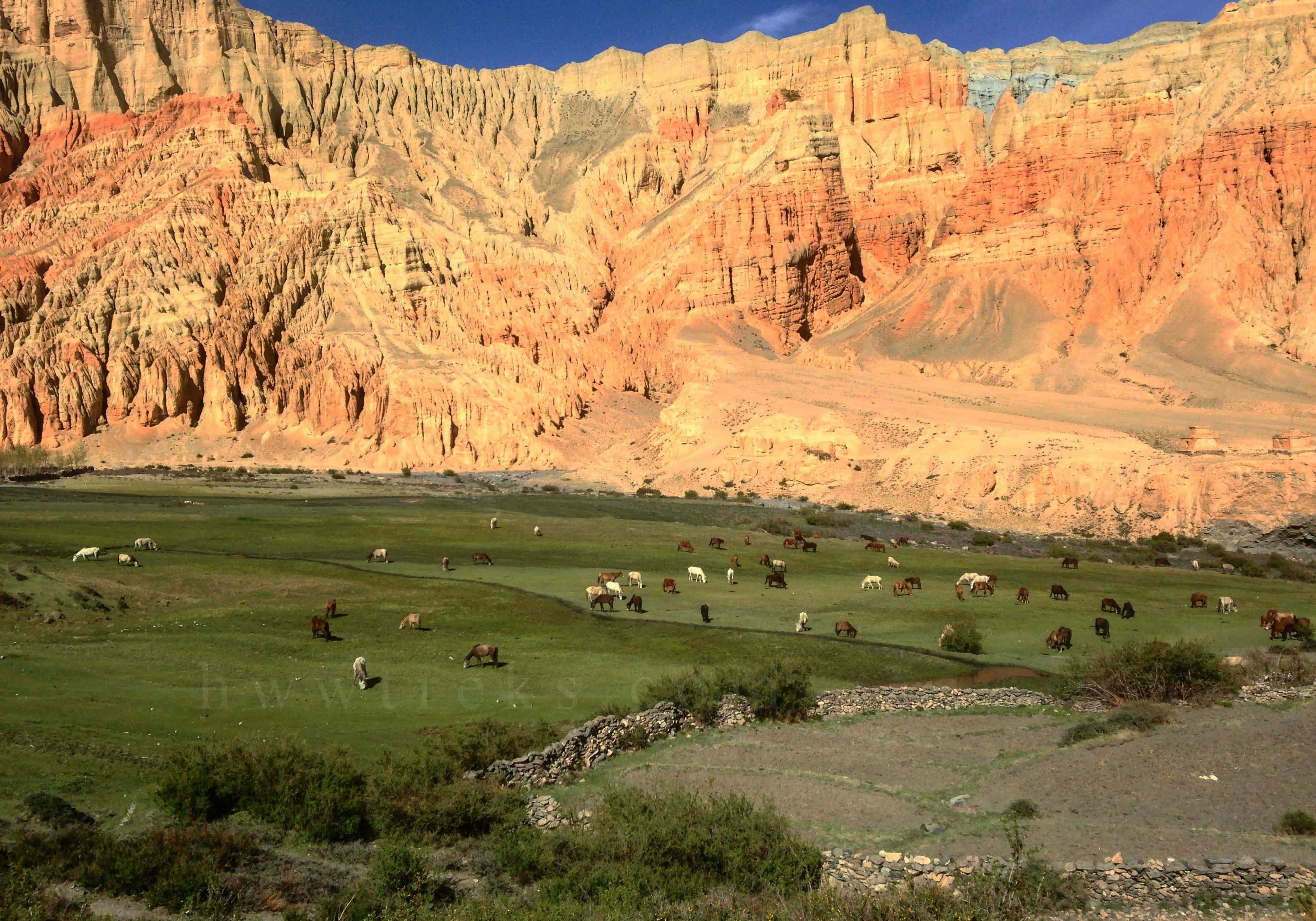
Dhakmar is a unique and spiritually significant village located in Upper Mustang. What makes Dhakmar stand out is its stunning red hills, which dominate the landscape. According to local legend and spiritual beliefs, the red color of these hills represents the blood of a demon that was slain by Guru Rinpoche (Padmasambhava), the revered Buddhist master who played a key role in spreading Buddhism in the region.
In addition to its spiritual importance, Dhakmar is renowned for its dramatic and unique landscape. The red hills create a striking contrast against the otherwise rugged terrain of the Upper Mustang region, offering visitors a visually captivating experience. The otherworldly appearance of the red cliffs and their connection to ancient legends make Dhakmar a place of profound natural and spiritual beauty.
18. Nomadic Yak Herders of Lo-Manthang

Nomadic Yak Herders of Lo-Manthang are decreasing as modernization makes life easier. If you haven’t seen the Tibetan nomadic lifestyle before, then now is the right time to visit them. In Upper Mustang, real Yak herders of Tibet can be seen. They mainly depend on yaks for milk, cheese, meat, clothes (wool), and many more. They spend their lives in temporary tents and move from place to place. Next to the black tent made from yak hair, a Tibetan Mastiff dog is kept to guard the tent when there is no one in the tent. Warm hospitality of Nomadic by offering you Tibetan tea prepared from yak butter and rock salt. All the nomadic places are settled below the mountain, where there is green pasture and a fresh-flowing stream.
Conclusion
Traveling to Mustang offers a rare blend of adventure, history, and spiritual discovery. Its ancient monasteries, mystical gumpas, royal heritage, and breathtaking landscapes and caves create a truly immersive experience. For a memorable journey, visit during the Tiji Festival or trek to sacred sites like Dzong Cave and Luri Gumba. Bring warm clothes for the high-altitude climate, and consider homestays for an authentic cultural experience. Mustang is perfect for those seeking adventure, peace, and a deep connection to Nepal’s rich traditions.
Read similar useful blogs regarding travel to Upper Mustang from the below lists:
- Best Treks in Upper Mustang
- Why you should visit Upper Mustang
- When is the next Tiji Festival of Lo Manthang?
- What is the Tiji Festival?
- Villages of Upper Mustangs
- Three Major Monasteries of Lo Manthang.
- Upper Mustang Trekking Guide
- Road Trip to Upper Mustang
- Bagcham of Namgyal Monastery
- Shaligram Shila (ammonite) of Mustang
- Hotels in Mustang



